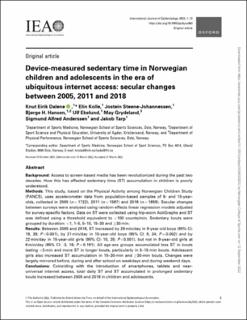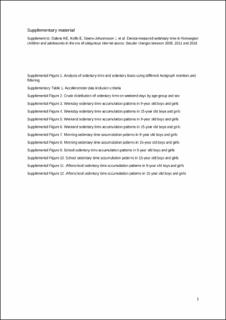| dc.contributor.author | Dalene, Knut Eirik | |
| dc.contributor.author | Kolle, Elin | |
| dc.contributor.author | Steene-Johannessen, Jostein | |
| dc.contributor.author | Ekelund, Ulf | |
| dc.contributor.author | Grydeland, May | |
| dc.contributor.author | Anderssen, Sigmund Alfred | |
| dc.contributor.author | Tarp, Jakob | |
| dc.contributor.author | Hansen, Bjørge Herman | |
| dc.date.accessioned | 2022-09-14T07:26:22Z | |
| dc.date.available | 2022-09-14T07:26:22Z | |
| dc.date.created | 2022-08-02T10:09:48Z | |
| dc.date.issued | 2022 | |
| dc.identifier.citation | International Journal of Epidemiology. 2022, Artikkel dyac063. | en_US |
| dc.identifier.issn | 0300-5771 | |
| dc.identifier.uri | https://hdl.handle.net/11250/3017683 | |
| dc.description | This is an Open Access article distributed under the terms of the Creative Commons Attribution License (https://creativecommons.org/licenses/by/4.0/), which permits unrestricted reuse, distribution, and reproduction in any medium, provided the original work is properly cited. | en_US |
| dc.description.abstract | Background: Access to screen-based media has been revolutionized during the past two decades. How this has affected sedentary time (ST) accumulation in children is poorly understood.
Methods: This study, based on the Physical Activity among Norwegian Children Study (PANCS), uses accelerometer data from population-based samples of 9- and 15‐year-olds, collected in 2005 (n = 1722), 2011 (n = 1587) and 2018 (n = 1859). Secular changes between surveys were analysed using random-effects linear regression models adjusted for survey-specific factors. Data on ST were collected using hip-worn ActiGraphs and ST was defined using a threshold equivalent to <100 counts/min. Sedentary bouts were grouped by duration: <1, 1–5, 5–15, 15–30 and ≥30 min.
Results: Between 2005 and 2018, ST increased by 29 min/day in 9-year-old boys (95% CI: 19, 39; P <0.001), by 21 min/day in 15-year-old boys (95% CI: 8, 34; P = 0.002) and by 22 min/day in 15-year-old girls (95% CI: 10, 35; P <0.001), but not in 9-year-old girls at 6 min/day (95% CI: -3, 16; P = 0.191). All age-sex groups accumulated less ST in bouts lasting <5 min and more ST in longer bouts, particularly in 5–15-min bouts. Adolescent girls also increased ST accumulation in 15–30-min and ≥30-min bouts. Changes were largely mirrored before, during and after school on weekdays and during weekend days.
Conclusions: Coinciding with the introduction of smartphones, tablets and near-universal internet access, total daily ST and ST accumulated in prolonged sedentary bouts increased between 2005 and 2018 in children and adolescents. | en_US |
| dc.language.iso | eng | en_US |
| dc.subject | accelerometer | en_US |
| dc.subject | adolescents | en_US |
| dc.subject | children | en_US |
| dc.subject | physical activity | en_US |
| dc.subject | screen-time | en_US |
| dc.subject | secular change | en_US |
| dc.subject | sedentary | en_US |
| dc.title | Device-measured sedentary time in Norwegian children and adolescents in the era of ubiquitous internet access: Secular changes between 2005, 2011 and 2018 | en_US |
| dc.type | Peer reviewed | en_US |
| dc.type | Journal article | en_US |
| dc.description.version | publishedVersion | en_US |
| dc.rights.holder | © The Author(s) 2022 | en_US |
| dc.source.pagenumber | 12 | en_US |
| dc.source.journal | International Journal of Epidemiology | en_US |
| dc.identifier.doi | 10.1093/ije/dyac063 | |
| dc.identifier.cristin | 2040558 | |
| dc.description.localcode | Institutt for idrettsmedisinske fag / Department of Sports Medicine | en_US |
| dc.description.localcode | Institutt for fysisk prestasjonsevne / Department of Physical Performance | en_US |
| dc.source.articlenumber | dyac063 | en_US |
| cristin.ispublished | true | |
| cristin.fulltext | original | |
| cristin.qualitycode | 2 | |

